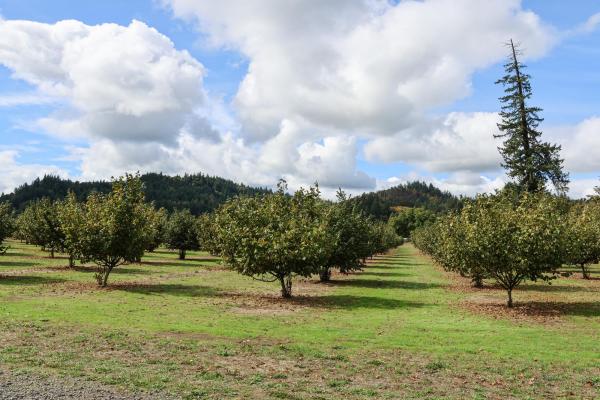
Una mirada al pasado del huerto y a su futuro
Dorris Ranch es uno de los parques más apreciados del Distrito de Parques y Recreación de Willamalane. Este parque, situado al norte de la confluencia de Willamette, es un lugar idílico para la recreación. Dorris Ranch atrae a ciclistas, caminantes y corredores por igual, pero este parque ofrece más que senderos pintorescos. Sus hileras de avellanos cuentan la historia del huerto comercial de avellanos más antiguo de los Estados Unidos.
En 1905, George y Lulu Dorris plantaron los primeros 50 avellanos en el rico suelo de Dorris Ranch. En las décadas siguientes, George Dorris estableció varios acres de vivero donde experimentó con diferentes métodos de cultivo de avellanos jóvenes. George Dorris se convirtió rápidamente en un líder en la industria de los avellanos a medida que el vivero se expandía, produciendo 70.000 árboles cada año. En 1951, más de la mitad de todos los avellanos comerciales de los Estados Unidos se podían rastrear hasta Dorris Ranch.
Avanzamos rápidamente hasta la década de 1970, cuando Willamalane adquirió por primera vez una gran parte de Dorris Ranch y creó el Plan de Uso de Tierras de Dorris Ranch, que prometía proteger y mejorar el valor histórico, cultural y ambiental del parque. Hoy, el parque contiene 70 acres de huertos comerciales activos que son administrados por un horticultor.
En 2015, se descubrió en los huertos una enfermedad fúngica mortal y de rápida propagación llamada tizón del avellano oriental. El tizón del avellano oriental comienza infectando los brotes de los árboles de avellano oriental y se propaga gradualmente por todo el árbol. En aproximadamente ocho años, esta enfermedad debilita y finalmente mata al árbol. Desde que se descubrió el tizón por primera vez en Dorris Ranch, Willamalane ha tomado medidas importantes para frenar la propagación de la enfermedad y salvar los huertos históricos, incluida la poda selectiva y los tratamientos químicos. A pesar de estos esfuerzos, el tizón del avellano oriental continuó amenazando la salud de los árboles y se propagó a casi todos los árboles de los huertos. Para preservar Dorris Ranch como un huerto de avellanos en funcionamiento, Willamalane comenzó a eliminar los árboles infectados con el tizón en fases y a reemplazarlos con variedades resistentes al tizón, con la intención de reemplazar casi la totalidad de las 70 hectáreas de Dorris Ranch. Hasta ahora, Willamalane ha reemplazado 30 acres de avellanos desde 2016. Hoy, estos árboles resistentes al tizón están prosperando, requieren menos tratamientos químicos y brindan cosechas anuales confiables de nueces.

Este mes de noviembre, gracias a una subvención del Departamento de Vivienda y Desarrollo Urbano, Willamalane comenzará su tercera fase de reemplazo de huertos para protegerlos de la plaga de la avellana oriental. Durante esta fase, Willamalane eliminará aproximadamente 40 acres de árboles infectados, triturándolos e incorporándolos al suelo del lugar. Esto significa que los nutrientes permanecerán en el rico suelo de Dorris Ranch y ayudarán con la retención de agua. Un huerto, el Road Orchard, permanecerá intacto para preservar la historia del parque. El Road Orchard servirá como un registro físico del espaciamiento temprano, los hábitos de crecimiento y las prácticas de manejo de los agricultores pioneros. También preservará la inclusión del parque en el Registro Nacional de Lugares Históricos como el huerto comercial de avellanas más antiguo de los Estados Unidos.
En 2025, comenzará una nueva era libre de plagas para los huertos. En el nuevo año, Willamalane plantará nuevos árboles para seguir haciendo crecer el legado de Dorris Ranch y preservar la importancia histórica de este lugar especial en nuestra comunidad de Springfield.
¿Interesado en seguir este proyecto?
- Obtenga más información sobre el Proyecto de Reemplazo de Huertos.
- Siga a Dorris Ranch y Willamalane Park and Recreation District en Facebook, y a Willamalane en Instagram para conocer historias y actualizaciones.
- Suscríbete al boletín de cierre de Dorris Ranch.
- Consulte las alertas y cierres del distrito.
